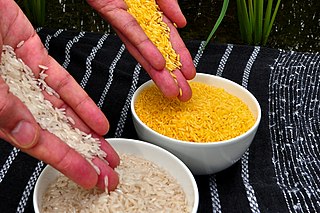
Human nutrition deals with the provision of essential nutrients in food that are necessary to support human life and good health. Poor nutrition is a chronic problem often linked to poverty, food security, or a poor understanding of nutritional requirements. Malnutrition and its consequences are large contributors to deaths, physical deformities, and disabilities worldwide. Good nutrition is necessary for children to grow physically and mentally, and for normal human biological development.

Malnutrition or nutritional deficiency occurs when an organism gets too few or too many nutrients, resulting in health problems. Specifically, it is "a deficiency, excess, or imbalance of energy, protein and other nutrients" which adversely affects the body's tissues and form. Malnutrition is not receiving the correct amount of nutrition. Malnutrition is increasing in children under the age of five due to providers who cannot afford or do not have access to adequate nutrition.
Micronutrients are essential dietary elements required by organisms in varying quantities throughout life to orchestrate a range of physiological functions to maintain health. Micronutrient requirements differ between organisms; for example, humans and other animals require numerous vitamins and dietary minerals, whereas plants require specific minerals. For human nutrition, micronutrient requirements are in amounts generally less than 100 milligrams per day, whereas macronutrients are required in gram quantities daily.

Iodised salt is table salt mixed with a minute amount of various salts of the element iodine. The ingestion of iodine prevents iodine deficiency. Worldwide, iodine deficiency affects about two billion people and is the leading preventable cause of intellectual and developmental disabilities. Deficiency also causes thyroid gland problems, including endemic goitre. In many countries, iodine deficiency is a major public health problem that can be cheaply addressed by purposely adding small amounts of iodine to the sodium chloride salt.

Helen Keller International combats the causes and consequences of blindness and malnutrition by establishing programs based on evidence and research in vision, health and nutrition. Founded in 1915 by Helen Keller and George A. Kessler, the organization's mission is to save the sight and lives of the most vulnerable and disadvantaged.

India's population in 2021 as per World Bank is 1.39 billion. Being the world's second-most-populous country and one of its fastest-growing economies, India experiences both challenges and opportunities in context of public health. India is a hub for pharmaceutical and biotechnology industries; world-class scientists, clinical trials and hospitals yet country faces daunting public health challenges like child undernutrition, high rates of neonatal and maternal mortality, growth in noncommunicable diseases, high rates of road traffic accidents and other health related issues.

Stunted growth is a reduced growth rate in human development. It is a primary manifestation of malnutrition and recurrent infections, such as diarrhea and helminthiasis, in early childhood and even before birth, due to malnutrition during fetal development brought on by a malnourished mother. The definition of stunting according to the World Health Organization (WHO) is for the "height for age" value to be less than two standard deviations of the WHO Child Growth Standards median.

Vitamin A deficiency (VAD) or hypovitaminosis A is a lack of vitamin A in blood and tissues. It is common in poorer countries, especially among children and women of reproductive age, but is rarely seen in more developed countries. Nyctalopia is one of the first signs of VAD, as the vitamin has a major role in phototransduction. Xerophthalmia, keratomalacia, and complete blindness can follow if the deficiency is more severe.

Animal source foods (ASF) include many food items that come from an animal source such as fish, meat, milk, eggs, honey. Many individuals do not consume ASF or consume little ASF by either personal choice or necessity, as ASF may not be accessible or available to these people.

Micronutrient deficiency or dietary deficiency is not enough of one or more of the micronutrients required for optimal plant or animal health. In humans and other animals they include both vitamin deficiencies and mineral deficiencies, whereas in plants the term refers to deficiencies of essential trace minerals.
Sight and Life is a humanitarian nutrition think tank with the goal of eliminating all forms of malnutrition in children and women of childbearing age.

Biofortification is the idea of breeding crops to increase their nutritional value. This can be done either through conventional selective breeding, or through genetic engineering. Biofortification differs from ordinary fortification because it focuses on making plant foods more nutritious as the plants are growing, rather than having nutrients added to the foods when they are being processed. This is an important improvement on ordinary fortification when it comes to providing nutrients for the rural poor, who rarely have access to commercially fortified foods. As such, biofortification is seen as an upcoming strategy for dealing with deficiencies of micronutrients in low and middle-income countries. In the case of iron, the WHO estimated that biofortification could help curing the 2 billion people suffering from iron deficiency-induced anemia.
Anemia is a deficiency in the size or number of red blood cells or in the amount of hemoglobin they contain.This deficiency limits the exchange of O2 and CO2 between the blood and the tissue cells.Globally, young children, women, and older adults are at the highest risk of developing anemia. Anemia can be classified based on different parameters, and one classification depends on whether it is related to nutrition or not so there are two types: nutritional anemia and non-nutritional anemia. Nutritional anemia refers to anemia that can be directly attributed to nutritional disorders or deficiencies. Examples include Iron deficiency anemia and pernicious anemia. It is often discussed in a pediatric context.
Despite India's 50% increase in GDP since 2013, more than one third of the world's malnourished children live in India. Among these, half of the children under three years old are underweight.

Nutrition International, formerly the Micronutrient Initiative (MI), is an international not for profit agency based in Canada that works to eliminate vitamin and mineral deficiencies in developing countries. Although often only required by the body in very small amounts, vitamin and minerals – also known as micronutrients – support an array of critical biological functions including growth, immune function and eye function, as well as foetal development of the brain, the nervous system, and the skeletal system. Micronutrient deficiency is a form of malnutrition and is a recognized health problem in many developing countries. Globally, more than two billion people live with vitamin and mineral deficiencies.
People living with HIV/AIDS face increased challenges in maintaining proper nutrition. Despite developments in medical treatment, nutrition remains a key component in managing this condition. The challenges that those living with HIV/AIDS face can be the result of the viral infection itself or from the effects of anti-HIV therapy (HAART).

Health in Mozambique has a complex history, influenced by the social, economic, and political changes that the country has experienced. Before the Mozambican Civil War, healthcare was heavily influenced by the Portuguese. After the civil war, the conflict affected the country's health status and ability to provide services to its people, breeding the host of health challenges the country faces in present day.
Malnutrition continues to be a problem in the Republic of South Africa, although it is not as common as in other countries of Sub-Saharan Africa.
Malnutrition is a condition that affects bodily capacities of an individual, including growth, pregnancy, lactation, resistance to illness, and cognitive and physical development. Malnutrition is commonly used in reference to undernourishment, or a condition in which an individual's diet does not include sufficient calories and proteins to sustain physiological needs, but it also includes overnourishment, or the consumption of excess calories.

Undernutrition in children, occurs when children do not consume enough calories, protein, or micronutrients to maintain good health. It is common globally and may result in both short and long term irreversible adverse health outcomes. Undernutrition is sometimes used synonymously with malnutrition, however, malnutrition could mean both undernutrition or overnutrition. The World Health Organization (WHO) estimates that malnutrition accounts for 54 percent of child mortality worldwide, which is about 1 million children. Another estimate, also by WHO, states that childhood underweight is the cause for about 35% of all deaths of children under the age of five worldwide.













